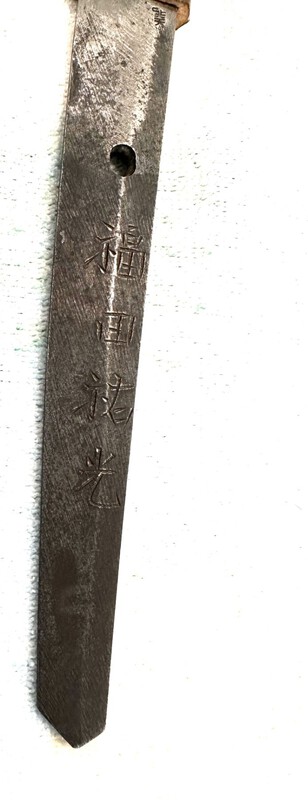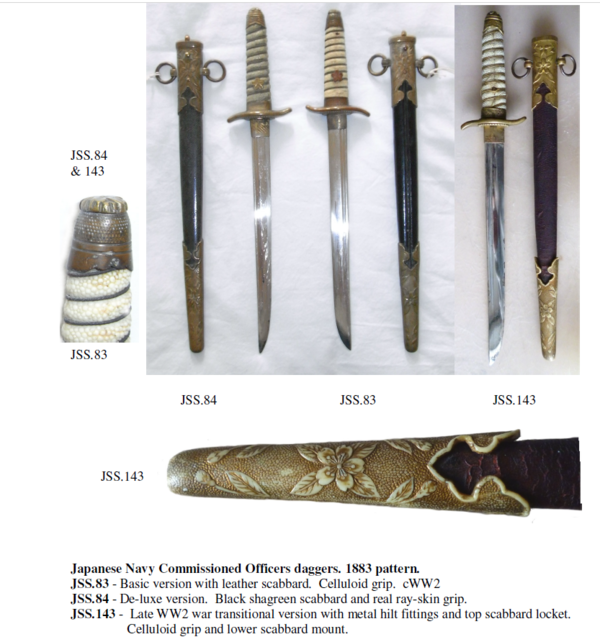-
Posts
13,763 -
Joined
-
Last visited
-
Days Won
169
Content Type
Profiles
Forums
Events
Store
Downloads
Gallery
Everything posted by Bruce Pennington
-
Joris, the fittings look pretty good. Looks like someone obtained WWII fittings (you can find the for sale without a blade) and put them on a Damascus blade. The date is October 1938. Is anyone able to read the smith name?
-

Info needed possibly looking to sell
Bruce Pennington replied to Rebeccacran's topic in Military Swords of Japan
My first choice would be our own Swords and Edged Weapons For Sale or Trade section of NMB. You'll save all the ebay fees and taxes. I know I've heard a guy or two talking about wanting one of these. If no luck there, then, personally, I'd try ebay. -

Info needed possibly looking to sell
Bruce Pennington replied to Rebeccacran's topic in Military Swords of Japan
As to market price, $450 is what I got mine for, however it is rare to see one sold as a souvenir. Almost all sellers market them as Navy kaigunto. But I've always felt they should be priced higher, more like Brian said. Rebecca, I don't see how or where you would get an official appraisal for this. You are currently talking with the only guys that really know what this sword is. Like the other guys said, the market itself is the real appraiser. They are worth whatever people are willing to pay for them. -

Info needed possibly looking to sell
Bruce Pennington replied to Rebeccacran's topic in Military Swords of Japan
Marcin, Thomas (Kiipu) recently figured out that this circled anchor was a generic, all purpose Navy inspection/acceptance stamp. Turns out that the Toyokawa Navy Arsenal had nothing to do with swords. The more elaborate circled anchor was the Naval inspector assigned to the Tenshozan factory, so still a Naval stamp, not a shop stamp. -

Info needed possibly looking to sell
Bruce Pennington replied to Rebeccacran's topic in Military Swords of Japan
Good catch, John, thanks! I only had 4 others on file, and they are all on Navy stainless blades - 3 mumei (now 4); one signed by Kiyomichi; all in kaigunto fittings. This supports the idea that this blade was surplus, made for the war but not used until afterwards in the souvenir. -

Info needed possibly looking to sell
Bruce Pennington replied to Rebeccacran's topic in Military Swords of Japan
@BANGBANGSAN @Kiipu The painted number seems to have a "40" more freshly painted over " 1 1 ? 2". Can you make out the number underneath? I'm thinking the "40" was a number put there, over the wartime number, while assembling the souvenir. -

Info needed possibly looking to sell
Bruce Pennington replied to Rebeccacran's topic in Military Swords of Japan
Hi Rebecca! What you have there is a Navy blade made by the Tenshozan sword company in the last days of the war, but mounted in souvenir fittings. Tenshozan contracted with the 8th Army PX (military version of Walmart) to sell over 8,000 of these souvenirs from 1946 to 1950'ish. The painted number - 11402 - tells us the blade was likely made before the war's end, but never used in combat. Many surplus blades were re-fitted for the souvenir contract and sold through the PX in Japan and later in Korea. Value? When honestly sold as souvenirs, they normally run about $450 USD. Navy kaigunto (Navy blades in proper Navy fittings) can go as high as $2,000 plus/minus. You can read about the souvenir operation in this article - The Mysterious NLF Gunto - A Souvenir PS: Could I possibly get a full length photo of the nakago (tang) for my records? I file and track these. -

What happens to collectons?
Bruce Pennington replied to Peter Bleed's topic in General Nihonto Related Discussion
It would be my honor, John. -

TRANSLATION ASSISTANCE FOR TYPE 95 HABAKI STAMPS
Bruce Pennington replied to Bazza's topic in Translation Assistance
I once started wondering if these could actually have been made/used for Chinese forces in the war, but quickly realized that wasn't possible. The stamps are clearly fake. If the Chinese forces were making these for their troops, they wouldn't have put Iijima, Gifu, Kokura, etc stamps on them. These are trying to claim they were made in Seki by Japanese firms - which is impossible due to everything about them being wrong. So, long story, short - one of the many fakes in this style. -

Translation Seki Arsenal Blade
Bruce Pennington replied to robinalexander's topic in Translation Assistance
I agree it looks like Sukemitsu with the "mitsu" almost rubbed out. Checking my files, though, none of the 6 I have used this mei. I guess he could have tried something fancy with this one. Here is a couple examples I have: -
Hi Jan, Sorry to say that's a well known fake. I keep a file on these. Would you mind posting a photo of the sword overall? Is it trying to be an NCO Type 95 or something else? I have several on file from this particular faker, and there is a usually a serial number at the bottom of the etching. Among other things, yours has a date (1940) on it, which is almost always the only date they put on these.
-

What happens to collectons?
Bruce Pennington replied to Peter Bleed's topic in General Nihonto Related Discussion
Peter, To answer your question about an introductory letter - It's nicely worded, yet I don't think I would respond to such an offer unless I already knew the individual sending it to me. The scammers are so rampant these days, my first reaction would be to assume it's a scam. Now, if you were known to me, then such a letter would be taken and honestly considered. -
Hi Adam, Sorry to say, but it is fake, Whoever makes these has really flooded the market with them as we see this one quite often. It's trying to be a Type 95 NCO sword, but everything is wrong about it. Take a look at the real one on Ohmura's site: NCO Gunto - 1935; Military Swords of Imperial Japan Japanese NCO swords did not have dates on them. But these fakes usually have "1940" on the blade. Yours is a little unique as it has "1934" on it - one year before they actually started making the Type 95s! That's just one of many things they get wrong, on these.
-
Damascus steel was (and is) used by the Chinese. Are the fittings in the style of WWII Japanese military? If not, it may simply be something made in China for the Chinese. Most we see here, though, are trying to imitate WWII Japanese military.
-
Might help, with the top one, to remove the handle. You can see the wooden peg that goes through it horizontally. Might be tapered and only come out in one direction, but simply tap it out and the handle will come off.
-

What happens to collectons?
Bruce Pennington replied to Peter Bleed's topic in General Nihonto Related Discussion
We all just got to witness the selling of the Plimpton collection. A few of our guys got to help disperse large chunks, but I don't remember who the primary guy was that seemed involved in the beginning. Mine, when I get hit with the proverbial truck, goes to wife, then daughter, neither of which is interested in them. So, I've made a notebook with the basics about each sword and have listed the contact info of a couple of guys they can reach out to if the want to sell them off. -

Why i dislike this dealer
Bruce Pennington replied to lonely panet's topic in Auctions and Online Sales or Sellers
I have never dealt with that shop. They seem to sell some really high quality blades. Only once or twice have I heard complaints about various practices. I wouldn't rush to assume the fittings were done by the seller. These swords have often passed through many hands over the past 80 years. There is no way to know who did the match-up, except for the rare cases where we've got photos of a previous sale and compared to the current sale, there was obvious fittings changes (not this seller, but another one). -
Kevin, The large Seki stamp, and oil quenching simply means the blade was not made in the fully traditional way. Not good or bad. It just depends upon what your collecting goals are. If you want a WWII sword, good quality, then I have found the blades with the large Seki stamp are usually quite nice with attractive hamon. A polish would likely bring out it's beauty. As you say, with the condition of the fittings, it would be worth having a shirasaya made. All this would bring your expenses higher than the market value of the sword, though. So, if you plan to re-sell, it is not cost effective to do all this. If you are keeping the sword, and would just like to see it in it's full potential, and have the cash to spend, go for it. That's a personal choice. Some folks, though, like to keep the war swords in their 'as-is' condition since it depicts the life of the sword to this date.
-

Doug Austin "Guntoartswords"
Bruce Pennington replied to Volker62's topic in General Nihonto Related Discussion
I know his dealer activity has stopped some time ago. I think he's on NMB - @Austo1 -
Thanks Piers! Guess HB had it right from the start.
-
Let’s see if we can get a Japanese resident to ID these trees- @Bugyotsuji Piers, what do you think?
-
I sent the pictures to Richard Fuller, and here are his thoughts: ”Hi Bruce I think its late war. I have one where the scabbard chape is entirely celluloid although the upper mount is brass. The grip appears to be proper same. The navy had to make swords and daggers for the last officer draft so the shortage of materials may well have necessitated faux materials”
-
Hoping to hear from guys that collect these. Looks legit in age, but never seen one with fully molded celluloid tsuka. Richard Fuller has one that used celluloid for the fittings, but don't know if this is along those lines or not. Here's Richard's We also know that Tenshozan was making and selling souvenir dirks after the war, but have no idea what they looked like as we've never seen one with the Army PX sales certificate.
-

Bamboo Leaf pattern Tsuba on Gunto with old blade
Bruce Pennington replied to Baka Gaijin's topic in Military Swords of Japan
Seeing these on fully civil swords seems to support Thomas' ( @Kiipu) idea that these were mass produced fittings during the war that were being used by both civilian buyers and Gunzoku.







